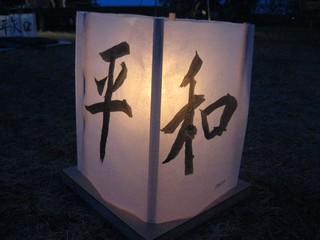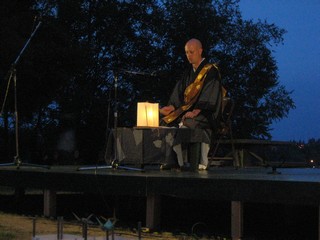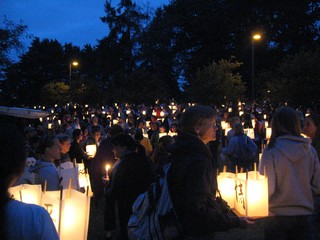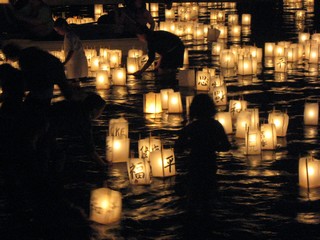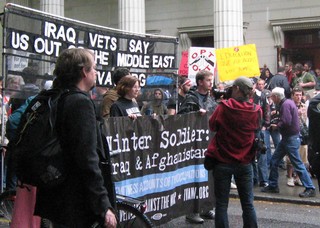I was running late for the peace rally Saturday and missed the first rally before the march. My timing was good for the march itself, however. It was less than a block away and moving toward us as they rerouted the bus around the corner. So, once I got off, I got my camera out, and after fumbling through changing my batteries when I didn’t have to (it was in display mode), got some great pictures.
Well, maybe not so great (this is me), but, a lot of them!
One good video from the camera as well, if I can ever figure out how to convert and upload it again. . .
I got caught up with the energy, which was really inspiring. It has been hard to maintain the momentum as this war drags on and the will of the people is ignored (whether the massive crowds at the start, in spite of the neo-cons trying to invoke Sept. 11 and claim anti-patriotism; or the overwhelming majority agains the war now). Unfortunately, hard as well to maintain the momentum with our fractured peace movement.
Yet, there everyone was; and many from far away (while I wish there were more Seattlites out). Kitsap, Bellingham, and, oh, yes, Portland!
I started seeing familiar faces in the crowd. Wait is that. . .? It’s been a little over a decade, but recognition is dawning. . . (and it was the same for them, with me). First a familiar face, other than George Hickey taking pictures (not that it isn’t good to see George). Yes, with a good camera (now gone digital, though I’ll bet George is still a holdout) and wearing a green army shirt. No, yes, that really has to be – Mike Hastie (from the Northwest Veterans for Peace in Portland)!
Lost sight of him in the crowd while taking my own pictures. Then turning a corner, I see a white haired gentleman in a NW Veterans for Peace t-shirt and filming the march with said, “Hey!” No flicker of recognition (from either of us), and I was thinking this must be a more recent member, since I’ve been gone. So I continue on. . .
I’m taking some photos of the Portland contingent when I see Mike again. I tap him on the shoulder. He looks real confused (“Who is this lady?”), then recognition, a big smile, and a hug. We talk a bit, then split up and go back to taking pictures, planning to look for each other after the march.
So I’m at the rally at the end of the march, in Occidental Park in Pioneer Square, and I see the guy in the NW Vets for Peace shirt again. I keep looking at him. . . wait a minute, it’s Don Mills. . . He looks at me, slightly puzzled. . . then sees it’s me! Don’s up here with Carolyn (of course), and Ted Kiser. So we find them and have a little reunion. Great to see them! Funny thing is, of all the people up from Portland, I don’t think I’ve seen any of them since I left (either up here at WTO etc., or my rare trips back to PDX).
They leave to head back to Portland. I move closer to check out the rally, remembering I want to keep an eye open for Mike.
We have someone speaking out for immigrant rights (Si, se peude! Still echoes of Magdaleno, now rabble rousing in Miami.) We’re surrounded by puppets – a grieving Iraqi mother, a man who wants to know why the U.S. is so afraid of the International Criminal Court, and, oh, yes, the Bush chain gang who were marching with us earlier (Bush, Cheney, Condi and Rummy).
Coming up next, the Bush bunch are on trial for their crimes against humanity. Charges are read. Congress is implicated, too – for inaction. They are found guilty and led away in chains.
Now, the disturbing thing to me is that some people were yelling, “Torture them!” during the trial. While I know it was the Bushies themselves who brought the whole subject of torture out in the open and have been trying to make it acceptable (while using Orwellian language to claim it isn’t really torture), it still troubles me. I don’t expect to hear it from “our side”. I like to think “we” are better (like I liked to think the U.S. was better, or at least our people, as we didn’t openly torture before this, and our government’s complicity with those who did was kept secret).
That’s the trouble though. Once the concept is out there, and discussion (and use) of it is considered to be possibly acceptable, even some of those on the other side of the debate can start to think, “Hey, let’s torture the torturers!” Come to think of it, the whole concept behind capitol punishment.
What I like about Amnesty International is that they have always been consisantly agains torture, and other human rights violations — in all cases. No excuses being made for one side or the other. Before yesterday, I thought we were mostly “preaching to the choir” in speaking out against torture in Seattle, as most people here are liberal, and “know better”. Now, I think, maybe the choir needs preaching too, to.
Hungry Mob, a hip hop band from Portland came up to wind up the rally. I was wandering around, wondering whether to head off, when I saw the AFSC banner at the edge of the square. Then, the boots. Rows of them. Some with flowers. Many with photos.
I took a lot of pictures. I ran into Mike again, taking photos as well. Then, I thought I’d go around to the backside of the display and take some more. First I saw there were rows of names and dates on what looked like Tibetan prayer flags. Then I realized there were more shoes here as well, pouring out of bags. Shoes to represent the Iraqi dead, which, of course, includes children. Mike lined up a shot including the sign reading “1 shoe represents 3000 Iraqi deaths” over a bag of shoes, with the moving posters of a grieving Iraqi woman, and a smiling Iraqi girl, behind.
The cost of war. A cost that’s been going on so long in Iraq. I met Mike and our other Veterans for Peace buddies in Portland protesting the Gulf War. A war started by Bush I against a dictator his administration used to support, while Saddam was gassing and committing other human rights violations against his own people. After the Gulf War, where we had destroyed the Iraqi infrastructure (water, sewer, electricty. . .), we continued to let their children starve to death as a tactic of war. When pointed out, well, that was Saddam’s fault. Really, we could enforce two “no fly” zones, but couldn’t make sure the food got to the children? Why does a whole country have to suffer for one man? Who’s gone now? Now the country is so bitterly divided (Iraq, though to some extent the U.S.), there is little hope. Having us stay as the occupier is doing nothing but cause yet more deaths. Now Bush wants war with Iran and God knows who else.
Mike was in earnest discussion with an Iraq War veteran before I left. The baton of leadership being passed on in a way to the next generation; the one who can speak fully to the truth of this war.
How many more generations does this need to go on?
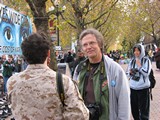
Tags: peace, Iraq+War, Veterans+for+Peace









